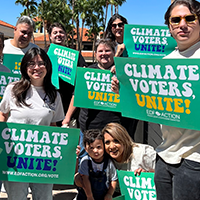Virginia’s Next Governor Must Eliminate Climate Pollution by 2045
Virginians are dealing first-hand with the impacts of the climate emergency that is facing our country and planet. From increased flooding to more intense storms, we have no time to lose – we must act now to ensure we have a prosperous economy and healthy communities.
And the good news is that Virginia’s next governor has a real opportunity to make the Commonwealth a national leader on climate change. As the 13th largest state economy in the nation and a major emitter of greenhouse gas (climate) pollution, Virginia must play a critical role in ensuring that the nation meet its climate goals. This has even more urgency as we see the daily toll climate change is having in Virginia, including flooding from hurricane Ida that washed away homes in western Virginia, and beyond to billion-dollar weather and climate disasters occurring across the country.
Virginia is already starting this critical work to rein in climate pollution. The state is a member of the US Climate Alliance and is one of the growing number of states that has established science-based goals for cutting climate pollution. Virginia aspires to reduce total climate pollution to net zero by 2045 across the economy, or in other words transition to a 100% clean economy, with ambitious and much-needed commitments to accelerate action in the power sector. However, like many other states, Virginia is not on track to meet its near- or long-term climate goals.
The chart below, based on data from Rhodium Group’s U.S. Climate Service, illustrates the projected gap between the state’s business-as-usual gross GHG emissions and the state’s emission reduction targets.
Guaranteeing goals are hit with a firm pollution limit
Virginia’s next governor will have a narrow window to put Virginia on the right path and close this emissions gap. We need to build on existing policies, like the Virginia Clean Economy Act, the Regional Greenhouse Gas Initiative (RGGI), and soon-to-be-developed Clean Car Standards, and set an ambitious agenda to put in place binding pollution reduction policies that guarantee Virginia will meet its economy-wide climate commitments. Putting in place firm, yearly pollution limits that account for all climate pollution in the state and steadily decline to allow net-zero pollution by 2045 is the easiest way to ensure the state stays on track and gets pollution out of the air on the schedule it needs to. Comprehensive action like this follows the lead of other states, like Washington, that are translating their commitments into ambitious, binding emissions limits that cover major sectors of their economies. By leading on economy-wide pollution reductions, Virginia can benefit in the growing clean economy – one analysis showed that reaching net-zero emissions could add $3.5 billion to Virginia’s GDP and create tens of thousands of jobs. Virginia currently has an estimated 93,200 people working in clean energy, with 8% growth expected in 2021, so it should capture this opportunity to accelerate economic growth even faster. States that fail to act decisively and quickly also risk being left behind as other states take ambitious steps to cut pollution and lead the nation in the growing clean energy economy.
Virginia’s next governor should heed the call of the majority of Virginians who see combatting climate change as a priority and establish a program that sets a declining limit on climate pollution across the economy, while accelerating reductions where they can most cost-effectively be achieved.
Policies that can keep emissions under the limit
Fortunately, Virginia is well-positioned to craft the policies we need to eliminate climate pollution. Virginia will be compiling its first-ever greenhouse gas emissions inventory starting next year, which will provide useful information that the state’s Department of Environmental Quality can immediately use to start writing regulations that cost-effectively drive down climate pollution across all sectors. There is no need to delay though – we know which sectors are responsible for climate pollution and we have the tools to start the work needed to meet our climate goals.
Major emitters, including the power, transportation, and industrial sectors, all have a critical role to play in helping Virginia meet its near- and long-term climate goals. The next governor should direct DEQ to immediately begin crafting regulations that lock-in the necessary pollution reductions and ensure Virginia will meet its climate goals. The state has the opportunity to join other leading states that are putting binding policies in place to achieve their climate goals – the new bar for climate leadership and the type of action that the majority of Virginians, major businesses, and communities can get behind.
We need leadership to get Virginia on the right path to address the climate crisis. We cannot miss this opportunity to ensure the state is well-positioned to be a leader in the clean energy economy. Virginia’s next governor should cement the state’s legacy as a national leader on climate change by taking decisive action to put the state on a guaranteed path to eliminate climate pollution and live up to its goals and commitments to all its citizens.



